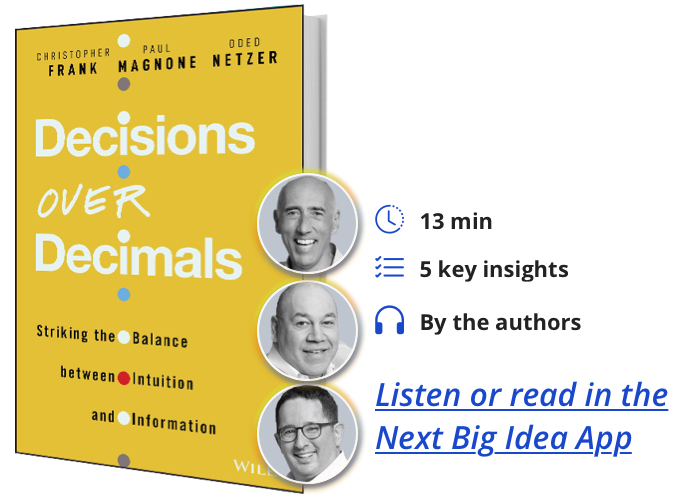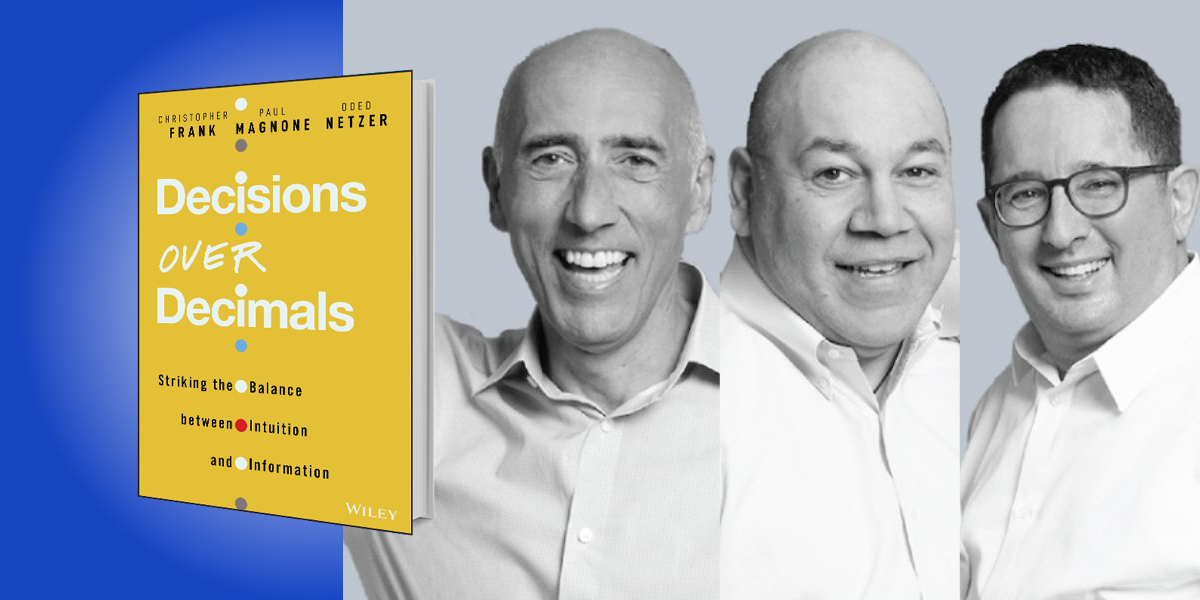Christopher Frank is Vice President of Global Marketplace Insights at American Express and Co-faculty Director at Columbia Business School. Paul Magnone is Head of Global Strategic Alliances at Google and Co-faculty Director at Columbia Business School. Oded Netzer is Vice Dean of Research, and Arthur J. Samberg Professor of Business at Columbia Business School, as well as an Amazon Scholar.
Below, Christopher, Paul, and Oded share 5 key insights from their new book, Decisions Over Decimals: Striking the Balance Between Intuition and Information. Listen to the audio version—read by the co-authors themselves—in the Next Big Idea App.

1. Why do people struggle with decision making?
A decision represents a change—a moment in time when you are asked to consider a different path. We are not wired for change. Organizations do not resist change—people do. This resistance weighs heavily on the decision-making process. Teams make slow decisions, misguided decisions, or no decisions at all. People are afraid of casting a decision that’s not right, not smart, or making a choice that’s not perfect.
People fear that an imperfect decision will impact their personal brand, performance rating, or next opportunity. So, we seek perfect decisions and often retreat to our comfort zones. This is counterproductive to agile decision-making—the perfect decision is a myth.
As we request more information, seek one more opinion, or ask for another spreadsheet, we end up with countless meetings and streams of additional data. Often, as we prolong the process, we find ourselves spinning.
The discussion becomes a debate and the decision process drags on, sapping our energy. The solution is to strike the balance between information and judgment. We call this skill quantitative intuition.
2. Use IWIK to effectively frame the problem.
Agile decision-making is grounded in how you think, not how hard you work. When a new project launches, team members often pounce and activity becomes confused with impact. People jump into meetings, emails churn, and data is pulled, tormented, and abused. At the end, everyone is fatigued and there may be a good decision, a poor decision, or no decision.
“When a new project launches, team members often pounce and activity becomes confused with impact.”
The smarter approach is having the right team focus on answering the essential question: what is the minimum viable decision, rather than the unachievable “perfect” decision. That means ensuring the team only collects the necessary data needed to balance their intuition, which starts with pinpointing the essential question.
Defining the essential question is deceptively simple. Ask: What do I wish I knew? The output is a series of statements, all beginning with, I wish I knew… or IWIKs™. IWIK acts as a catalyst to bring clarity to an issue.
The IWIK statements your colleagues or clients generate lead to a deeper understanding of their needs. IWIKs enable you to determine the questions you need to answer during the research or analysis phase. You discover the unique needs of various stakeholders and create alignment between the effort, the outcome, and the decision.
The key to IWIK framing is the word wish, which grants permission for open exploration. There are four parts to the IWIK process: 1.) Ask, 2.) Brainstorm, 3.) Capture, and 4.) Deliberate.
The IWIK approach can expose the root cause of the situation that needs to be solved. IWIKs enable focus on the essential question and prioritization of data discovery, analysis, and delivery efforts, leading to efficient and effective decisions.
3. Put data in context.
Many hoped that with the arrival of Big Data we would get rid of gut decision making, with all its biases. Now we are beginning to realize that while data is of tremendous value for decision making, uncertainty and the need for human judgment remain.
Intuition still plays a role, but it’s a different type of intuition than was needed in the absence of data. We call this Quantitative Intuition (QI). At the heart of QI is asking precise questions, interrogating the data from a business perspective, synthesizing the information to make a good decision, and finally delivering the decision to compel action.
“The main skill needed to interrogate data is not a technical one, but rather putting data in the context of the business.”
We tend to think that good data interrogators are skilled in statistics. Those who can check if the analysts used the shiniest tool to analyze the data. This is again a myth. The main skill needed to interrogate data is not a technical one, but rather putting data in the context of the business. To do so, you must look at it in 1.) absolute terms, 2.) over time, and 3.) relative to what’s going on elsewhere. Interrogating the data from a contextual perspective rarely sits with the data science team, it is often with the business units and top management.
A deceptively simple question can advance data interrogation. Ask: What surprised you? Surprise happens when the information does not match your priors or your intuition. Statisticians tend to call these surprises outliers and dismiss them, but surprises are often the heart of the story. Surprises are exactly where you should focus interrogation.
When an analyst comes to me after two weeks of number crunching with a deck of slides full of tables, I tell them, I promise we will look at your slides but before first tell me one or two things that were surprising in your journey through the data. This one question cuts to the chase for uncovering insights (and sometimes important mistakes). Meaningful insights occur at points of surprise.
4. Synthesize, do not summarize.
Once you’ve gained a few insights it is time for synthesis. Synthesis is the combination of data and judgment. It is the transition from analysis to recommendation by adding human judgment and putting analysis in the context of its environment. It is the ability to connect the dots rather than summarizing the information.
Consider a resident learning to become a doctor in an ER at a hospital. The resident accepts incoming patients and checks vitals and runs necessary tests. She then reports the results to the attending physician without providing a diagnosis. A skilled attending physician would turn to the residents and say, You have spent the last 20 minutes with a patient, this is the first time I am seeing them, what do you think they have? They would encourage residents to provide a synthesis, and we should do the same with our analysts.
These skills are extremely important and tend to be missing, particularly among junior employees. Unfortunately, pouring judgment into data analysis is rarely taught.
“Make time to discuss the so what and now what informed by the data.”
At organizations, we spend hours in meetings discussing the “what” aspect of the data. What does the data tell? Is it accurate, can we get more, or different data? We are persuaded by the seemores, people who simply ask in every meeting to see more data. Synthesis moves from what to so what—what does this information mean—and now what—what are we going to do about it. Make time to discuss the so what and now what informed by the data.
Once you arrive at a synthesis, make the bottom line your top line. Start with reporting the implications of the analysis followed by only the needed facts to support the decision.
5. Decisions are shaped by time, risk, and trust.
One reason we make misguided decisions is that we’re not considering all the relevant variables. We lack a frame for decision-making that helps us quickly consider underlying factors.
A decision should be based on data insights plus human judgment—not on the pressures of time, fatigue, bias, or sheer organizational momentum. We can build a simple framework containing the main forces that shape the decision moment: the elements of time, risk, and trust.
Do we have a tight time frame forcing a swift decision? Or is the deadline flexible? Time defines the constraints on data discovery and the range of questions that can be explored. Then, is it low or high risk? Is the decision situational or will it have a broader impact? Finally, is the information trustworthy? Does the messenger have a track record of insightful synthesis or are they passing on raw data?
The stakeholder navigating a decision triangulates time, risk, and trust. They will also consider reversibility: is a decision permanent? The confident decision maker will focus on being approximately right rather than burning resources and becoming precisely wrong.
To listen to the audio version read by co-authors Paul Magnone, Christopher Frank, and Oded Netzer, download the Next Big Idea App today:































